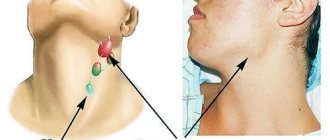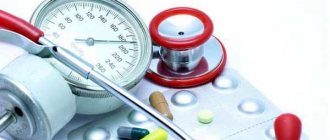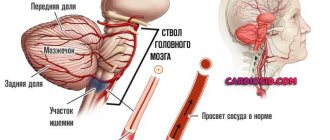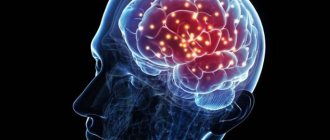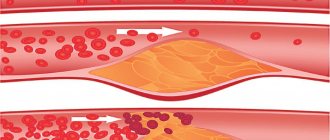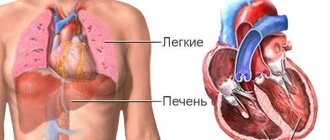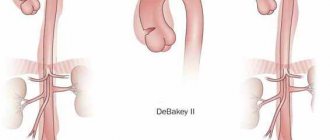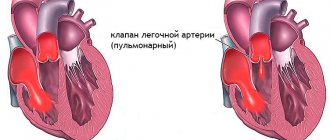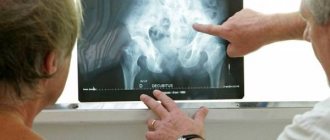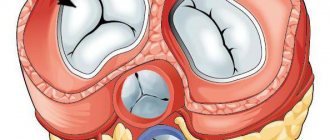Causes and mechanism of development
The main cause of the disease is poor circulation. There is a disturbance in the flow of blood into the brain and its various parts, as well as its outflow from the cavity of the cranium. Diseases such as arterial hypertension, atherosclerosis, vasculitis, thrombosis, thrombophlebitis, and diabetes mellitus lead to pathology.
Discirculatory encephalopathy can occur due to genetic pathology, as a result of birth trauma, or prolonged hypoxia in the prenatal period. Factors that worsen the course are traumatic brain injuries, osteochondrosis, alcoholism, obesity, physical inactivity. Mental and mental stress, lack of sleep, and overwork also contribute to the development of the disease.
Deterioration of blood supply to the brain, damage to small and large vessels leads to the death of neurons and auxiliary (glial) cells, as well as the formation of soft areas with reduced density. The white matter is the first to suffer - it is the most vulnerable. This is followed by damage to the gray matter.
A constant lack of oxygen leads to disruption and destruction of connections between the subcortical elements and the cortex, and destruction of nerve cells. The result is emotional, cognitive and movement disorders. In all likelihood, in the first stages of the disease, disturbances appear only functionally and can be compensated. The functions of dead cells can be taken over by neighboring cells.
The progression of the disease leads to neurodegenerative processes and organic lesions that cannot be compensated.
Stages of the disease
According to the Research Institute of Neurology of the Russian Academy of Medical Sciences, there are 3 stages of dyscirculatory encephalopathy.
Stage I. It is reversible and is characterized by local organic lesions of the brain. Clinical signs are mild, social adaptation is not impaired.
Important! Stage I DEP often occurs in children and young people, but due to subtle signs, diagnosis becomes difficult and can be confused with another disease.
Causes of the disorder:
- lack of healthy sleep,
- unhealthy diet
- violation of the environmental situation,
- insufficient physical activity.
Stage II. Progressive. Motor and mental disorders become more obvious, social and professional adaptation suffers.
The person becomes incapacitated, but is still able to perform the simplest actions for personal care (change clothes, eat, go to the toilet). However, the patient can often injure himself. In this case, it is possible to assign 2 or 3 disability groups.
Kinds
Discirculatory encephalopathy most often occurs as an acquired disease, but cases of congenital pathology are possible. The latter is caused by unfavorable factors accompanying pregnancy and childbirth.
The speed of onset of symptoms allows us to talk about slowly progressing, remitting and rapidly progressing pathology. The duration of the first is measured in years. It may take 15 years between the appearance of the first symptoms and disability.
Remitting dyscirculatory encephalopathy leads to a faster deterioration of the patient's condition. Its peculiarity is the alternation of periods of exacerbation and normalization of the condition. Typically, persistent, permanent defects occur within 10 years.
The galloping (rapidly developing) form can lead to disability or even death within 2-3 years.
Depending on the leading cause, the following types of discirculatory encephalopathy are distinguished:
- Atherosclerotic. It develops due to the appearance of protein and lipid compounds on the walls of blood vessels. They reduce the lumen of blood vessels, thereby reducing the volume of circulating blood. The main highways that provide blood flow to the brain and regulate its volume are damaged.
- Venous. The main cause of the disease is a violation of the outflow of venous blood. Stagnation occurs, poisoning the brain with toxins and causing inflammation.
- Hypertensive. Associated with spasms, thickening and rupture of the walls of blood vessels. The disease progresses rapidly. It can develop in young people. The acute form of the disease occurs immediately following an increase in pressure and can be accompanied by epileptic seizures and agitation. In a chronic course, there is gradual damage to small vessels.
- Mixed. This form contains signs of hypertensive and atherosclerotic forms. A decrease in blood flow through the main vessels is accompanied by hypertensive crises.
In some cases, encephalopathy of combined genesis is isolated. The disease develops when the blood supply is disrupted, toxic exposure or injury.
Disability with a diagnosis of "DEP 2nd degree"
At the second stage of the disease, many patients may already be assigned a disability. The group will depend on the severity of the symptoms.
The third group is assigned when diagnosed with DEP stage 2. Its symptoms are so pronounced that they interfere with ability to work. But the patient has not yet lost the ability to self-care; he rarely needs outside help in everyday life.
The second group is assigned to the third degree of DEP. Symptoms suddenly limit a person's ability to live. As a result of his illness, he had already suffered a mini-stroke.
So, we explained that this is a diagnosis of “DEP of the 2nd degree.”
Symptoms
Dyscirculatory encephalopathy in the first stages of the disease resembles a condition that appears during normal overwork and fatigue. Emotional, cognitive and motor impairments are clearly visible.
A bad mood gives way to excitement, excessive joy, then apathy, indifference to everything, agitation, and aggressiveness arise. The main characteristic of the emotional state of a person is depression and apathy. At first, these two traits remind themselves occasionally, but over time they become more active and fill a person’s life more and more, leaving no room for positive emotions, enthusiasm, and optimism.
Cerebrovascular disease is characterized by deterioration of intelligence. The patient begins to forget difficult words and names, and gradually loses the ability to analyze a large amount of material obtained from reading, learning new things, and communicating. He ceases to understand himself, loses the ability to self-control and introspection. Can't plan his day or work. Over time, he ceases to recognize others, his street, his house, and does not understand the time. Many actions are based on impulse rather than logical connections.
Indifference covers all areas of activity - work, hobbies. Attention is attracted to insignificant tasks that seem easy, feasible, and do not require concentration or memory work.
Motor activity also suffers. At first it is fine motor skills - the patient cannot thread a needle or write something. Later, tremors of the arms and legs appear. Obsessive movements occur. The person loses coordination and sometimes falls. Speech suffers - it becomes blurred and unclear.
The patient complains of a headache, a feeling of fullness, spots before the eyes, and sounds in the ears. Vomiting occurs when walking. During the day, drowsiness haunts you, and insomnia becomes a frequent visitor at night. Vision decreases, while one eye sees normally, but in front of the second everything seems to be plunging into fog.
Symptoms
In the first stages of development, the manifestations of the disease are insignificant and hardly noticeable. A person lives unaware of a cerebrovascular accident until the first signs appear:
- Asthenia (muscle weakness).
- Pain in the head area.
- Dizziness, transient confusion.
- Increased fatigue.
Symptoms of grade 1 DEP are mild, which makes it difficult to determine the diagnosis and choose treatment. Similar symptoms are characteristic of many neurological and somatic diseases (mental disorders, infectious diseases in the prodromal phase), which makes it difficult to make a diagnosis based on single symptoms. The diagnosis is made if abnormalities typical for the pathology are observed for 6 months or more. Symptoms of progressive pathology moving into stages 2 and 3:
- Increasing deterioration of cognitive abilities. At stage 3, vascular dementia develops.
- Psychovegetative disorders - anxiety, depression, asthenia, changes in sensitivity and reaction to external stimuli.
- Movement disorders of the pyramidal type (spasticity, seizures).
- Motor disorders of the extrapyramidal type (hypokinesia, parkinsonism).
The severity of cognitive disorders depends on the volume of brain tissue that has undergone atrophic changes. DEP is often accompanied by cephalgic seizures. The following syndromes develop: pseudobulbar (impaired swallowing functions, speech impairment, involuntary laughter, crying), amyostatic (slowing of voluntary movements, limitation of motor activity), vestibulocerebellar (impaired balance and motor coordination).
Diagnostics
In order to establish the diagnosis of dyscirculatory encephalopathy and its stage, a specific algorithm has been developed. It includes several steps:
- At the initial appointment, the patient’s condition is assessed and blood pressure is measured. The complaints of the patient and his relatives are listened to.
- A neuropsychological study is carried out to confirm the functioning of the brain.
- Symptoms that may characterize CVD and possible causes and factors of its development are identified.
- The cause-and-effect relationships between objective data obtained using instrumental research methods and identified disorders of the emotional, cognitive and motor spheres are determined.
- Other diseases are excluded.
All studies are prescribed by a neurologist. At the appointment, he checks tendon reflexes, signs of vestibular disorders, tremors, and muscle rigidity. The doctor monitors possible speech problems, cognitive and emotional disorders. Prescribes blood tests to see the general formula, levels of sugar, cholesterol, lipoproteins, and features of the clotting process.
Diseases of the cerebral vessels can be diagnosed using rheoencephalography. The examination will provide information about their elasticity, tone, blood supply, and resistance.
Doppler ultrasound allows you to determine the speed and direction of blood flow, assess the integrity of blood vessels, and detect blood clots.
Electroencephalography makes it possible to assess the electrical activity of the brain in response to stimuli.
MRI provides three-dimensional images of brain structures with a clear pattern of vascular tissue, possible neoplasms, and hemorrhages. The study provides information about blood flow and the condition of blood vessels.
Computed tomography allows you to see atrophic processes, the condition of arteries, veins, and blood circulation features. When performing a CT scan with a contrast agent, the structure of tissues, some parts of the brain, neoplasms, and signs of inflammatory processes are analyzed.
Diagnosis includes a neuropsychological examination. The patient’s ability to perform a series of movements, carry out operations related to logical thinking, and processing information obtained using hearing, vision, and sensations is clarified.
The presence of signs of hypertension is an indication for an ultrasound examination of the adrenal glands and kidneys.
If discirculatory encephalopathy is suspected, consultation with an ophthalmologist and cardiologist is indicated. The ophthalmologist will check the fundus of the eye and determine the breadth of vision. The cardiologist will prescribe a heart examination, clarify the presence of cardiovascular pathologies and their nature.
The use of various diagnostic methods will allow us to determine the extent and stage of brain damage, as well as prescribe therapy.
Treatment
Discirculatory encephalopathy requires serious, multifaceted treatment. Its goals are to get rid of the underlying disease, prevent the risk of hemorrhage, and restore blood supply and brain function. Includes non-drug, medicinal, surgical methods. Traditional medicine is often used.
Drug therapy
Drug treatment of dyscirculatory encephalopathy of the brain depends on the causes that caused it. To normalize blood pressure, the following groups of drugs are used:
- Sartans. Medicines in this group block the interaction of neuroreceptors with hormones that cause vasoconstriction and increased blood pressure. Sartans include Losartan, Hipotel, Valz.
- Diuretics. Their action is aimed at removing fluid from the body and reducing swelling, including vascular walls. Diuretics: Hypothiazide, Indapamide, Veroshpiron, Furosemide, Torasemide.
- Beta and alpha blockers. Medicines suppress adenoceptors, leading to vasodilation and decreased contraction of the heart muscles. Drugs in this group: Conco ram, Methanoprolol, Gedralazine, Doxazosin.
- ACE inhibitors. They act on the enzyme that converts angiotensin I into angiotensin II. Medicines in this group: Enalapril, Captopril.
- Calcium antagonists. Medicines inhibit the penetration of calcium into the cells of the muscular tissue of the heart and blood vessels, reduce arrhythmia, and improve blood circulation. This group includes Diltiazem and Lacidipine.
Atherosclerosis should be treated with drugs that improve lipid metabolism, accelerate fat metabolism, absorb cholesterol from the intestines, and inhibit its production. Sermion, Vinpocetine, Piracetam are prescribed. Some of the medications lead to a decrease in blood pressure, so they must be taken carefully with antihypertensive drugs in the treatment of a disease of mixed origin.
For any form of dyscirculatory encephalopathy, neuroprotectors are prescribed. Drugs in this group improve metabolic processes in the brain. Actovegin and Gliatilin are often used. Cerebrolysin is used for intramuscular injections.
Aspirin and Tenecteplase will help prevent the formation of blood clots.
Non-drug therapy
For the treatment of dyscirculatory encephalopathy of the 1st degree, therapeutic massage and physical exercise are prescribed. To improve blood circulation and dilate blood vessels, radon and oxygen baths are indicated.
Electrosleep therapy improves brain metabolism and stimulates the establishment of new connections between neurons.
During galvanotherapy, weak currents are applied to the collar area. This improves blood circulation and metabolism.
Much attention is paid to a healthy lifestyle.
Surgical intervention
A severe form of the disease with severe narrowing of blood vessels is an indication for surgical intervention. Stenting, endarterectomy, and bypass surgery are performed.
Stenting involves placing a stent where the artery is narrowed. It acts as a vascular wall, dilates and supports the vessel.
During endarterectomy, atherosclerotic plaque is removed from the affected vessel.
Bypass surgery involves creating a bypass for blood flow. To do this, a piece of an artery or vein is taken from another part of the body and sewn into the vessel before and after the obstruction. Another way is to suture the affected artery to another brain vessel.
Traditional medicine methods
It is impossible to cure the disease with folk remedies. However, they will help improve blood circulation, memory, and relieve headaches.
To prepare the Crimean collection, take 1 tablespoon of a mixture of flowers and fruits of rose hips, linden, oregano, horsetail, birch leaves, sweet clover, plantain, coltsfoot, raspberry fruits and dill seeds. Steam in a glass of water and leave for 20 minutes. Drink 3 times a day before meals for 3 months. The product stimulates brain function and tones.
A drink made from hawthorn will relieve headaches. A glass of berries is steamed in a water bath for 10 minutes. The resulting decoction is infused for 12 hours and drunk a glass 3 times a day before meals.
Prevention
To treat DEP, prevent its occurrence and transition to more severe stages, it is recommended to lead a healthy lifestyle. The patient is advised to give up alcohol and smoking. It is necessary to exclude semi-finished products and fried foods from the diet, replace fatty meat with lean meat, eat more vegetables, fruits, and lean sea fish. It is recommended to control your weight, walk, play sports, taking into account your general condition and age.
It is important to provide yourself with normal rest, sleep at least eight hours a day. Take vitamins as needed.
conclusions
Modern medicine does not stand still, but doctors say that it is very difficult to overcome the disease in its final stages, although it is possible to improve the condition of patients.
After all, in order to protect yourself from this disease, you need to follow fairly simple rules that will help you always feel healthy and full of strength.
It is enough to lead a healthy lifestyle, exercise, eat right, and then you will have a long, fulfilling life.
Forecast
With DEP 1, the prognosis is favorable. The progression of the disease is unlikely to be stopped, but it is possible to reduce the severity of symptoms and lead a full life. To do this, it is important to maintain a healthy lifestyle and adhere to medical recommendations.
When the disease moves to the second stage, recovery can only be said if the cause that caused it can be eliminated surgically. Otherwise, the disease progresses. Gradually the patient's condition will worsen and lead to disability. Timely comprehensive treatment of DEP 2 allows you to delay the appearance of signs of the third stage for up to 10 years.
Discirculatory encephalopathy is a complex disease that destroys the emotional, cognitive and motor spheres of human life. The prognosis can be favorable with early detection of pathology, its treatment and prevention. Pronounced symptoms indicate an organic lesion and are difficult to treat.
Diagnosis of DEP 2nd degree of mixed origin
Symptoms may improve during treatment, resulting in a person’s quality of life improving. If the necessary therapy is not available, the signs continue to progress, more and more new symptoms are added to them, and then the pathology develops into the third stage.
Among the expected complications is ischemic stroke, which can develop at any stage of the disease with a diagnosis of DEP of the 2nd degree of mixed origin.
